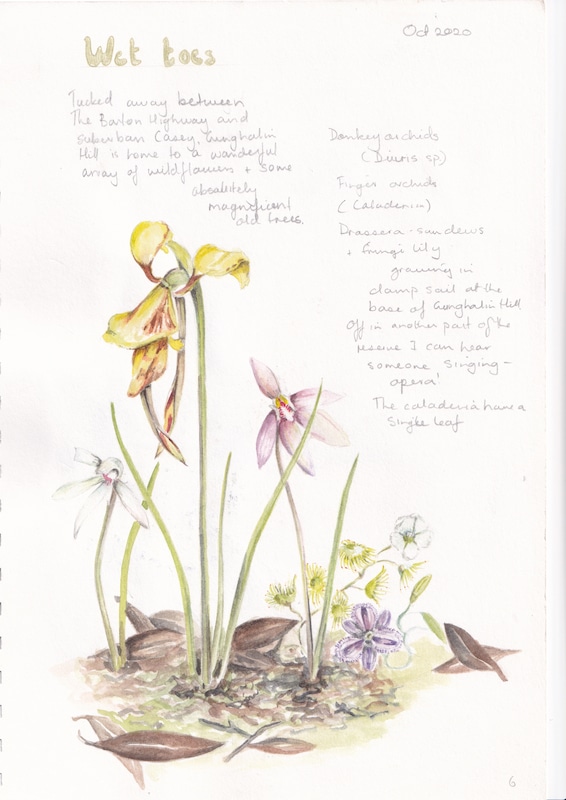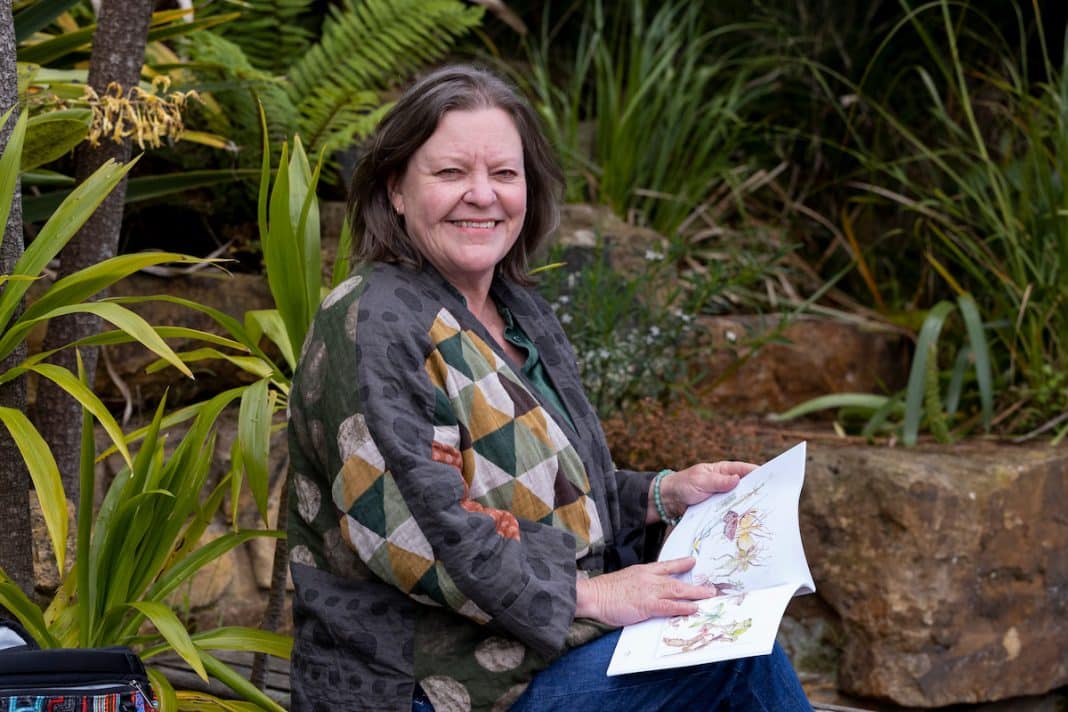Have you ever heard of nature journalling? One part meditation, one part citizen science, it’s a pastime that fosters curiosity.
According to local woman Fiona Boxall, it may also be a means of inspiring protection for the local environment, including towards locally beloved, but unprotected nature spots like Bluetts Block.
“There are as many ways to nature journalling as there are nature journallers. It’s about your own personal response to an environment,” she says.
“It encourages you to stop and look and respond … rather than seeing what’s around you as just a blur.”
Fiona, 64, is a “sort of busy retired writer”, an ex-journalist and current journaller. While she stumbled into nature journalling as a retiree, her love for the bush goes back to being a “nearly naked nature kid” in Papua New Guinea, then relocating to the NSW Southern Highlands.
“My mum used to kick us out of the house regardless of rain, hail or shine, and we’d go charging through the bush – kilometres and kilometres sometimes.
“My grandmother was a really good gardener, and she had a posse of, what seemed like, ancient little old ladies who also gardened.
“In retrospect, they were about my age,” smiles Fiona.
“Nature and gardens were my big passions as a kid … even in student accommodation and share houses, I used to try and create a garden.”
After years of writing as a garden journalist, Fiona retired and moved to Canberra to be closer to her daughter.
“Growing up, everyone that left my small town went to Sydney, because why would you go to Canberra?
“I had this pre-existing idea of Canberra being grey, dull, and full of public servants. But only two of those are true!
“The natural spaces are so intertwined with the Canberra landscape that you can’t go anywhere without falling into one, or walking through one, or driving past one.
“I fell in love very quickly. The first morning after we moved, I woke up and heard galahs and wattle birds, not traffic and trains.”
Today, Fiona calls Canberra ‘Australia’s best-kept secret’, particularly for nature journallers.
While the nature journalling movement was popularised by a man, American naturalist John Muir Laws, Fiona notes that the pastime dates back to the Victorian era, with early records of ladies using watercolour to document wildlife and wildflowers.
As well as the importance of greenspace for our mental health, nature journalling creates an intimate relationship with the nearby environment and, in cases like the Backyard Bird Count, compiles huge bodies of data for scientific research.
“Plus, it’s lovely,” says Fiona, “to just be able to say ‘sorry, gone nature journalling’.”
Here are Fiona’s top three nature spots in Canberra:

- Gungahlin Hill is amazing. It’s a very small walk through a piece of original bushland, just sitting beside the highway. There are lots of parrots, lots of orchids … It is important to be respectful, as with all of these places. Don’t pick flowers or tread willy-nilly.
- Mount Rogers and Mount Taylor are not particularly well-kept secrets. However, follow the wallaby paths (carefully) to find a different type of vegetation from what you will see right next to the trail.
- One place that everyone should visit is Bluetts Block, out near Western Creek on the edge of Denman Prospect. It’s under threat of development, but it’s a biodiversity hotspot, with bush canaries, robins, and beetles. If you find the lookout, you can see all the way down to the river.
Wondering how to get started? A cheap notebook from the op shop, according to Fiona.
“So often we expect to be great at everything, and it’s just a recipe for putting it away and never touching it again. I’ve got friends who’ve bought beautiful journals and really nice pencils and then were so horrified at the thought of ruining it, that they won’t use them.
“Nothing’s ever perfect. And that’s the whole point.”
Got your cheap notebook? The next step is to relax into your lookout spot and sit for a few minutes to get a feel for the place. In a species-rich area, you’ll inevitably see something soon.
“The last time I was up at Bluetts Block, the view was amazing but there were all of these little jewel bugs mating everywhere,” Fiona smiiles. “So, I drew them, and intruded on their privacy.”
She notes that the true value of the nature journalling movement is inspiring people to care about what we already know.
“We heard the science; we ignored the science. People don’t listen to the scientific dialogue because it’s frightening, it’s painful, it goes over their heads.
“This, for me, is recognising that there is an emotional connection, which prompts people to become more proactive. “When you realise that this is something you love, when you think ‘I couldn’t bear to lose this. My life would be poorer for it,’ that’s when people will take the steps, go out and make a difference,” Fiona says.
Canberra Daily would love to hear from you about a story idea in the Canberra and surrounding region. Click here to submit a news tip.



